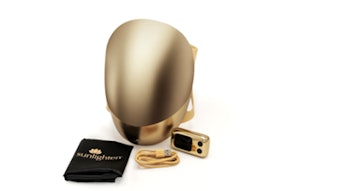The esthetic industry constantly is exploring new ways to change the structure and appearance of the skin. Oxygen is one of the latest contributions to the field. Modern technology has eliminated many of the inconveniences associated with providing this type of service in a spa setting.
The history of oxygen skin care began with its topical application to hasten the healing of burns. In hospital environments, pressurized oxygen in tanks is utilized. The disadvantages of this delivery method within a spa are obvious; the tanks require refilling and pose a potential fire hazard.
Oxygen skin care is based on the premise that stable natural oxygen increases skin cell metabolism. All cells require natural oxygen, which consists of two atoms bound together by a stable covalent—or chemical—bond. This is not to be confused with unstable forms of oxygen, which are known as free radicals.
The most common free radical is a single oxygen atom. These atoms are unstable, due to unpaired electrons in their outer shell. Free radicals react readily in a chemical process called oxidation. Cell membranes are the most vulnerable to this type of damage, which can be neutralized by the benefits of antioxidant nutrients.
Delivery methods
Early practitioners utilized dry oxygen application techniques—clients wore a face mask or inhaled oxygen. It soon was determined, however, that applying oxygen in conjunction with a liquid solution—commonly referred to as serums or hydrosols—offers several advantages. First, the chemistry of the liquid can be used as a healing tool. In addition, the substance is effective as a coupling medium for transferring one product to another location. In this case, liquid solutions carry oxygen directly into the epidermis.
Due to their disbursement capabilities, reasonable cost and easy clean-up features, nebulizers are the preferred application vehicle for administering oxygen skin care. The sole purpose of these plastic or glass devices is to create a mist of fine particulate solution, so the more consistent the particulate size, the better the infusion.
Plants and peptides
Plants have a long history of providing multiple topical skin care benefits. Naturally occurring groups of phytochemicals promote skin health by alleviating inflammation, neutralizing free radicals, toning blood vessels, improving circulation and cell membrane function, and reducing bacteria levels. The synergistic effect of topical oxygen combined with the multiple compounds found in plant-based hydrosol solutions provide a balanced natural approach to promoting optimum skin function.
New to the science of skin care are peptides, which are sequences of amino acids—the building blocks of protein. A number of these peptides are of interest in the field of anti-aging. Peptides have been shown to be effective in reducing fine lines and wrinkles. Anti-aging oxygen skin care hydrosols consist of a mixture of plants and peptides—the best of nature and science.
The art of application
In oxygen skin care, there are several factors that affect the art of application. The first of these is the amount of time that oxygen remains on the epidermis. The longer the contact with the desired area of the skin, the more optimal the outcome. The liquid flow rate must be precise enough so as to avoid overflooding the skin. When administered in the proper amounts, oxygen and liquid solutions can be applied to the targeted section for an extended duration and with better results.
The second factor is referred to as etching, which is the process of working a given line or wrinkle in order to flatten it. This is accomplished through longer oxygen contact time in which the skin’s metabolism can be stimulated to achieve an enhanced effect.
The proper equipment
Oxygen concentrators produce the substance in a natural form by drawing it from room air, which consists of 21% oxygen, 5% inert gas and 74% nitrogen. A properly operating concentrator will deliver 95% oxygen.
Ordinary oxygen concentrators are designed to produce a sufficient amount for a single user to inhale within a home environment. These types of concentrators do not have the performance capabilities to be used in providing modern oxygen skin care. The ones that are utilized in esthetic services extract oxygen, filter particulates, and reduce or eliminate a wide variety of indoor air pollutants.
Estheticians or spa owners who are looking to purchase an oxygen machine for use in their skin care practice should keep the following criteria in mind in order to select a device that will last them the length of their career.
1. As stated previously, a well-functioning machine will produce 95% oxygen. This percentage is critical, because the higher the outflow concentration, the better the results. An important consideration involves individual state rules and regulations. Some states will not allow the use of 100% USP (U.S. Pharmacopeia) tanked oxygen in esthetics. Be sure to check with your state board to see what is allowed in the state that you practice.
2. Outflow pressure is what drives the application of oxygen. In order for the applicator—or nebulizer—to work properly, at least 25 pounds of pressure is required. An ordinary concentrator will deliver only 12 pounds of pressure. An inadequate amount will yield a poor outcome.
3. Keep in mind that volume is not necessarily important in oxygen skin care. Only a small amount of oxygen can be pushed through a nebulizer. Consequently, machines that offer the largest outflow rating may not be the most cost-effective options.
4. Noise—or the lack thereof—is a key consideration for both the esthetician and the client. A loud oxygen machine in your treatment room will create a distraction for you and your clientele for many years to come. (END HANGING NUMBERS)
Economics of oxygen skin care
Oxygen skin care can be marketed to a spa’s clientele as a stand-alone service or as one component in a package of multiple procedures. Get creative, and come up with some enticingly named hydrosol formulations to add to your menu, such as “Anti-aging Wonder,” “Fiji Floral Collection” or “Hawaiian Healing.” A brief description of these available options will enable clients to determine their application solution of choice.
Anti-aging oxygen skin care, in which plant- and peptide-based hydrosols are used, is especially popular. The client receives a topical application with a 21-day supply of nutritional supplements. When the supply runs out, the individual returns for a new box of nutrients, as well as an examination and a progress report. In my practice, I see many clients who come to me on this schedule for their regular skin care needs. I bundle the two procedures into one fee, which would be lower than if each component were to be purchased individually.
The medical spa side of oxygen skin care involves treating skin conditions that have been diagnosed by a dermatologist. Hydrosols blended from plants provide anti-inflammatory properties. In this case, the client would return for treatment on a prescribed basis, and a fee for each service would be determined.
Clients who receive exfoliation treatments at your spa will benefit from oxygen skin care at the conclusion of their procedures. Hydrosols containing replenishing properties work to calm the skin, reduce inflammation and tone blood vessels. Combine the billing of all services into a set fee for these clients.
Dollars and sense
The business side of oxygen skin care involves the cost of liquid solutions (averaging $3 per treatment), time spent (average of 10 minutes per treatment) and the financial return on each treatment (based on the fee charged). As a stand-alone procedure, a $50 treatment nets a profit of $47. Time spent is returned at almost $5 per minute. When combined with consumable products and other spa services, this revenue can be enhanced significantly.
Topical oxygen skin care is a new noninvasive spa service that delivers high levels of client satisfaction, as well as significant repeat business. As an esthetician or spa owner, it could be an investment that pays off long term with substantial financial returns.










